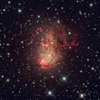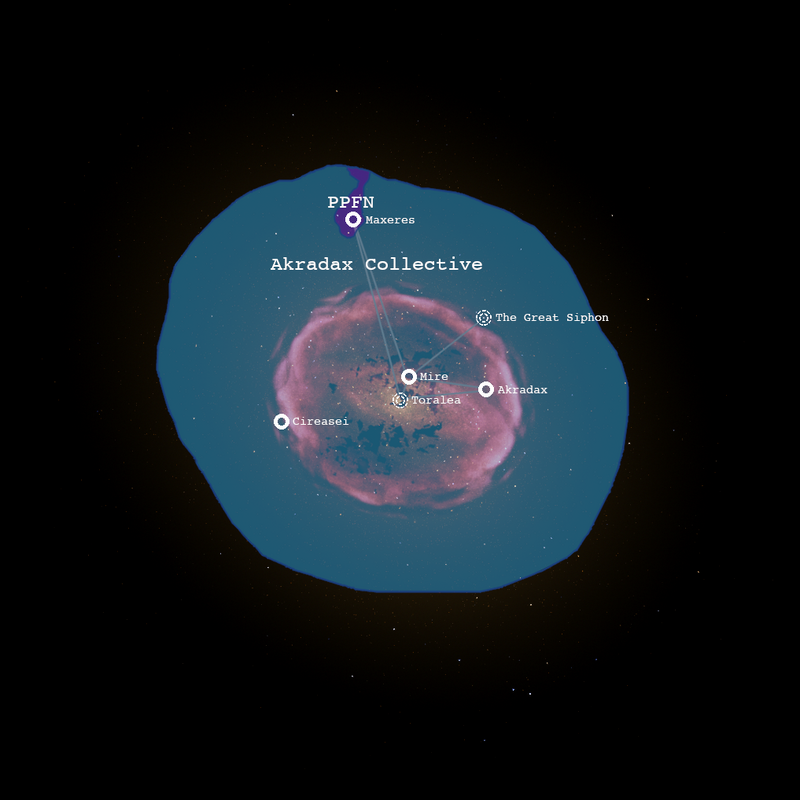The Flower Galaxy is a large, extremely flocculent spiral galaxy, similar in size to the Aylothn Galaxy. It is located just outside the Aylothn-Sagittaria Group, roughly ten million ly away from the Via Sagittaria Galaxy. The Flower Galaxy is known mostly for its rather large size, being the largest galaxy in the Telusian Group. The galaxy contains many life-forms, and is remarkably decentralized compared to its neighbors. The galaxy is controlled by hundreds of different empires and republics, a notable one being the Cnara-Frealee Federation, a K2.5 civilization near the galactic core. The Flower Galaxy is not particularly well known, but it has a vast history, close to rivalling the Ambrosia Galaxy.
The most powerful force in the galaxy is the United Nations of the Flower Galaxy, which claims much of the galactic core in its territory. The federation is centered on the Cnara System, an old K-type star with several planets and is located in an unusually calm region of the galaxy, allowing mass extinctions to not occur too often. This led to remarkably fast development of life, leading to the Carleans arising relatively early compared to other life, allowing it to amass a large amount of territory.
Overview
This galaxy was named Flower Galaxy, superseding earlier designations from extragalactic civilizations, due to its pretty, flower-like shape. It is the home of 1.2 trillion stars, hundreds of billions of planets, and countless species of intelligent life. The galaxy is so fertile that almost one in thirty systems in the galaxy has at least one world with native life, making it one of the most life-filled galaxies in the universe, coming in second to Ambrosia.
It was the home galaxy of the Providence Union, a vast empire covering most of the galaxy and rivaling the ancient Etymology of Ambrosia in strength. It was destroyed by a hail of black hole bombs by a large band of rebels over a billion years ago. Its second largest satellite, the Lareas Galaxy, was also home to the ancient Lareas Alliance, the oldest known civilization in the local universe, which seemingly vanished off the map a little over seven billion years ago.
Simplified Timeline
- Formation Era (13,100,000,000-11,800,000,000 BCE): This was when the Flower Galaxy and its satellites were forming. The galaxy and most of the rest of the universe was completely uninhabitable during this time, as there was an extreme overabundance of large stars that went supernova.
- Pre-Providence Union Era (11,800,000,000-2,400,000,000 BCE): In this era, many civilizations rose and fell, ranging from embryonic to almost type III. This is when the Lareas Alliance briefly conquered most of the Flower Galaxy, before it completely vanished off the map, leaving nothing but ruined dyson swarms.
- Providence Union Era (2,400,000,000-950,000,000 BCE): This is when the mid-type III Providence Union united the galaxy and has begun to colonize the satellites. Near the end of this era, hundreds of black hole bombs went off, utterly destroying most of the major systems. What was left was unable to pick up the pieces, and the Union collapsed. It is still unknown who triggered the bombs.
- Formation Era: The Sequel (950,000,000-4,500,000 BCE): Not much happened in this era. The Lareas Galaxy passed close to the galactic disk, triggering a massive burst of star formation.
- Telusian Civilization Era (4,500,000-3,000,000 BCE): This is the era when the galaxy was under the control of the Telusian Civilization.
- Present Era (3,000,000 BCE-present day): The current era. This era is filled with the birth of hundreds of civilizations, from embryonic to late Kardashev II. One of the most powerful existing ones is the Cnara-Frealee Federation.
Full timeline can be found here
Species
Civilizations
The Flower Galaxy contains hundreds of different civilizations, filling every galactic region and satellite galaxy (with the depressing exception of the Morid Galaxy) with life. As of the modern day, the political landscape within the galaxy itself is relatively peaceful, though this is certainly not the case for most of the satellites. The United Nations of the Flower Galaxy is presently the dominant power in the Flower Galaxy, as many of its member nations are superpowers in their own right.
| Name & Flag | Location | Capital | Species | Government | Civilization Type |
|---|---|---|---|---|---|
| Flower Core, Frealee Arm | Carleans, Darvikans | Federation of States | TBA | ||
| Frealee Arm, Flower Core | Salakela | Constitutional Monarchy | TBA | ||
| Paleas Arm | TBA | Democratic Republic | TBA | ||
| Charity Arm | Poreltids | Federal Republic of States | TBA | ||
| Galactic Halo | Scargass | Constitutional Monarchy | TBA | ||
| Elerad Arm | Rorazals | Transitioning out of a Plutocracy | TBA | ||
| Frealee Arm | TBA | Communist Democratic Republic | TBA | ||
| Nalachi Cluster, Akradax Galaxy | Elkeres, Deviri | Elite Democracy | TBA | ||
| Elerad Arm | Areial | Federal Union of States | TBA | ||
| Charity Arm | TBA | Social Democracy | Type 3.025 | ||
| Charity Arm | TBA | Theocratic Absolute Monarchy | TBA | ||
| Elerad Arm | TBA | Authoritarian Monarchy | TBA | ||
| Charity Arm | TBA | Democratic Federation | TBA | ||
| Charity Arm | TBA | Federal Union of States | TBA | ||
| Paleas Arm | TBA | Totalitarian Dictatorship | TBA | ||
| Paleas Arm | TBA | Democratic Republic | TBA | ||
| Paleas Arm | TBA | Difficult to Classify (really likes purple though) | TBA | ||
| Paleas Arm | TBA | Democratic Republic | TBA | ||
| Paleas Arm | TBA | Totalitarian Dictatorship | TBA | ||
| Paleas Arm | TBA | Theocratic Oligarchy | TBA | ||
| Akris Arm/Iriat Nebula | TBA | Unknown | TBA |
| Name & Flag | Location | Capital | Species | Government | Civilization Type |
|---|---|---|---|---|---|
| Lance Galaxy | TBA | Confederation of States | TBA | ||
| Lance Galaxy | TBA | Less of a government and more of a movement | TBA | ||
| Myrmidan Galaxy | TBA | Hive-mind | TBA | ||
| Myrmidan Galaxy | TBA | Loose Alliance | TBA | ||
| Myrmidan Galaxy/Exurian Cluster | TBA | Theocratic Republic | TBA | ||
| Lareas Galaxy | Virekas | Totalitarian Dictatorship | TBA | ||
| Lareas Galaxy | Ornali | Democratic Republic | TBA | ||
| Lareas Galaxy | TBA | Union of States | TBA | ||
| Lareas Galaxy | TBA | Democratic Republic | TBA | ||
| Blossom Galaxy/Zakha Arm | TBA | Alliance of States | TBA | ||
| Blossom Galaxy/Blossom Core | TBA | Federation of States | TBA | ||
| Blossom Galaxy/Akhad Arm | TBA | Constitutional Monarchy | TBA | ||
| Blossom Galaxy/Lowiras Bulge | TBA | Transitioning to a Direct Democracy | TBA | ||
| Akradax Galaxy | Tiradaats | Democratic Republic | TBA |
Galactic Geography
The exact galactic geography of the Flower Galaxy has been hotly debated, as it was often decided rather arbitrarily by whatever nation was most powerful at the time. As a result, what defines a distinct region of the Flower Galaxy has changed time and time again, going from being based on distance from the core, to being based on spiral arms, to being based on how far above or below the disk you are.
Currently, the Flower Galaxy is composed of seven main regions as set by a committee of the United Nations of the Flower Galaxy, each with its own interesting set of cultures and species.
- Flower Core
- Frealee Arm
- Elerad Arm
- Charity Arm
- Paleas Arm
- Akris Arm
- Galactic Halo
- Rapier Ring
Some consider the Satellite Galaxies to be regions of the Flower Galaxy but this has been completely dismissed by the aforementioned committee. Also, each region contains roughly 200 billion stars.
Map
Flower Core
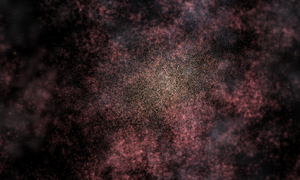
The Providence Cluster and Nebula
The Flower Core is the innermost region of the Flower Galaxy. Its borders span from The Heart of Providence to the edges of the galactic bulge. Because of this, this region is the most densely packed of any galactic region in this galaxy, with the average distance between non-gravitationally bound stars only reaching a third of a light-year, and a total star count estimated to be twenty billion stars, roughly a fifth of the galaxy's entire star count.
The layout of the Flower Core consists of an extremely dense cluster roughly five light-years across with over a thousand stars, many of them very massive and bright, surrounding The Heart of Providence. This cluster is nested within a less dense, but still quite dense cluster known as the Providence Cluster, composed of many old stars and old planets and is often called the Deep Core. This cluster does not have very many civilizations, and has a good deal of rogue planets with the many close encounters between stars over its long history. Across the bulge, many smaller clusters have formed, including the Cnara Cluster, the home of the planet Carlea and the Cnara-Frealee Federation.
During the Providence Union Era, most of the capital planets of the Providence Union were very densely populated and situated in the Flower Core, meaning that the majority of the resources produced by the galaxy were funneled into the core, leaving the majority of the galaxy, bar special exceptions, stricken with poverty, a fact which would eventually lead to their downfall. Though this practice was hated by even many in the core itself, it was maintained by the ruling elite of Revarea and other planets to their destruction roughly one and a half billion years ago.
The Heart of Providence fully formed around 13,000,000,000 BCE. After this, the first stars of the galaxy would begin to form throughout the remainder of the 12,000,000,000 BCEs. In the billions of years that followed, countless other stars, planets, and lifeforms would continue to come into being, forming many civilizations which have risen and fell over the galaxy's long history.
Countless species and civilizations have arisen in the Flower Core, most notably the Providence Union, which formed at the end of the Peony Wars and would go on to rule the entirety of the galaxy and portions of others for a time.
Frealee Arm
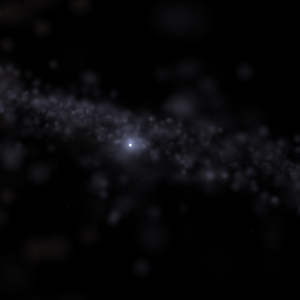
The reaches of the Frealee Arm
The Frealee Arm is the "first" arm and second officially recognized region of the Flower Galaxy, and is home to such notable planets as Darvikus, Saleas, and Astra. Its borders are defined as the spiral arm containing the Frealee System, which contains a large amount of gas, dust and star forming regions. It is the smallest region of Flower by star count, with roughly 14 billion stars.
Its layout is fairly compact when compared to the larger regions of the galaxy, with the average distance between stars spanning around one and a half light-years, causing the region to be inhabited by numerous clusters of gravitationally bound stars. Various civilizations have been founded within the borders of the Frealee Arm, with the most notable being the Economic Federation of Saleas, one of the founding members of the United Nations of the Flower Galaxy.
The Frealee Arm is divided into the Inner, Mid, and Outer Frealee Arm.
Charity Arm
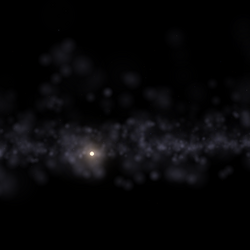
The Charity Arm, with some random star in the foreground.
The Charity Arm is the second arm of the Flower Galaxy and third officially recognized region. It is home to many nations, including the Marakat Interstellar Union, Trezhath Republic, and more. The Charity Arm is not fully controlled by the UNFG, with many nations having refused to join it. The Charity Arm is notably stricken with poverty in many places, and the UNFG is working to fix this.
The population of the Charity Arm is notably quite spread out compared to the Frealee Arm and Flower Core, with less than a third of its population. It is not entirely known why this is.
The Charity Arm is notably home to The Grey Star, an anomalous region of space roughly the size of a K-type star under heavy study by the UNFG, located in the territory of the Trezhath Republic.
The Charity Arm is divided into the Inner, Mid, and Outer Charity Arm, with the Outer Charity Arm being mostly unexplored.
Elerad Arm
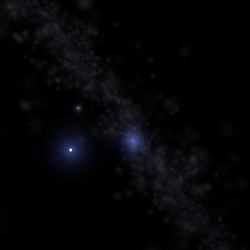
The Elerad Arm, with the LBV Inielus in the foreground.
The Elerad Arm is the last arm of the Flower Galaxy and last dense region of the galaxy. The Elerad Arm is notably depopulated due to the Sagittarium Invasions in the 20000s CE, and only contains two major nations, the Free Nation of Garrea and Areial Union.
Some of the other nations of the UNFG are trying to recolonize the vast empty areas in the Elerad Arm, and this destruction is what gave most of the Flower Nations a distrust of humans, which is why they aren't under the thumb of the Confederacy of Borealis.
Today, some of the galactic disk globular clusters are controlled by Sagittarium to this day, and they have become significantly more peaceful, mostly just staying in their respective clusters. The UNFG is debating whether to oust these remaining colonies or just leave them there.
The Elerad Arm is split into the Inner Elerad and Outer Elerad Arms. The Outer Elerad Arm is, as far as anyone can tell, utterly lifeless, with no native civilizations.
Paleas Arm
The Paleas Arm is very distant arm of the Flower Galaxy, separating from the Elerad Arm, on the opposite side of the Flower Galaxy relative to the Akradax Galaxy and the main territory of the United Nations of the Flower Galaxy. It is controlled by several bickering nations with wildly differing philosophies. The region is currently in a spell of peace between the recurring periods of war. Tensions are high, and the peace talks are almost certainly going to break quite soon.
The Paleas Arm is controlled by nations including the Beltamar Union, the Zepharis Republic, the Eltor-Lathemir Commonwealth, and many others, with a complex web of alliances ensuring that every nation in the area is dragged into the furnace of war every time hostilities break out.
The Paleas Arm is split into four regions: The Inner, Mid, and Outer Paleas Arms, and the Paleas Flocculent Cloud. The Beltamar Union, the Zepharis Republic, and the Eltor-Lathemir Commonwealth are located here in the Flocculent Cloud. The main portion of the arm is mostly controlled by colonies from these nations.
Akris Arm
The Akris Arm is the most distant and unexplored arm of the Flower Galaxy, breaking off from the Elerad Arm and extending to the furthest reaches of the halo. The Akris Arm is not very well-explored, with no known settlements in the region except the former location of Meral. The Akris Arm is the source of many strange broadcasts, and the UNFG is looking into this.
The Akris Arm is near the Lance Galaxy, and its largest nation, the Encalet Confederacy, is currently beginning to colonize its outer reaches. The Encalet Confederacy is currently training its telescopes at the arm, in an effort to determine the source of the broadcasts.
The Akris Arm is notably home to the Iriat Nebula, a nebula uniquely located outside the disk proper, the only large nebula in the galaxy like this. The Iriat Nebula is home to the Oralat Virtual Utopia, a reclusive civilization living on matrioshka brains around medium-sized stars hidden in the nebula. Despite its reclusiveness, the OVU is the only contacted nation native to the region.
Galactic Halo
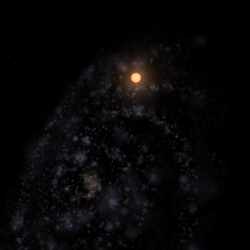
A star floating lonely in the reaches of the deep Galactic Halo.
The Galactic Halo is the sparsest region of the Flower Galaxy. It is not home to many nations, being controlled almost solely by the Kingdom of Saihera and the Pecay-Po Federation of Nalachi. It is the largest region of the galaxy in terms of volume, but its stars are very spread apart with average distances between stars being upwards of ten light-years. Because of this sparseness, this region is difficult to govern, and the two nations here have developed their own strategies for governing this region.
The Kingdom of Saihera is a very decentralized nation, with the King or Queen having very little power over the outer regions, while the PPFN remains holed up inside its dense globular cluster. It is unknown if these solutions will continue to work.
Rapier Ring
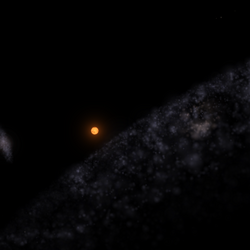
A lone star in the Rapier Ring.
The Rapier Ring is an interesting region. It is composed of a stream of stars extending out from the Lance Galaxy, wrapping around the full width of the galactic disk twice. Some consider this region to be part of the Galactic Halo, or even part of the Lance Galaxy itself. The territory of the Encalet Confederacy, the largest nation in the Lance Galaxy, extends partways down the Ring, but the rest of it is mostly ungoverned, and is as such commonly a home for outlaws.
Satellite Galaxies
What is or is not a satellite galaxy is up for debate. The boundary between a satellite galaxy and an intergalactic overdensity or globular cluster is sometimes unclear. However, there are currently 23 officially recognized satellite galaxies surrounding the Flower Galaxy, at various distances.
Major Satellites
Myrmidan Galaxy

The Myrmidan Galaxy from the outside.
The Myrmidan galaxy is the closest of the three major Flower Galaxy Satellites. Only containing approximately 700 million stars, Myrmidan only contains seven contacted intelligent species. It orbits at a very close proximity to the Flower Galaxy, and is in a polar orbit around it. Its orbit is slowly degrading, and it will likely soon collide with the galaxy, triggering a wave of star formation.
Currently, the Myrmidan Galaxy is controlled fully (except for a few footholds at the edges) by the reclusive Somnar Hive, a hive-mind empire which the entire UNFG is fighting against to buy time for the last free inhabitants of the galaxy to escape the galaxy.
Lareas Galaxy

The Lareas Galaxy from outside its borders, with the endless scars of war hidden from view.
The Lareas Galaxy is the most distant and second largest of the major satellites. The galaxy contains roughly ten billion stars, and interestingly has a higher colonization percentage than Myrmidan, even though it's more distant. It is a very active star former, and it has a large amount of large stars and nebulae. Lareas is currently split in three between the Republic of the Spider Nebula, the Union of Narenna, and the Kormin Empire, and the galaxy is ravaged with a war that has been ongoing for centuries.
The Lareas Galaxy used to be a lot closer in the distant past, and once even brushed past the Flower Galaxy, creating the life-filled Lareas Arm.
Blossom Galaxy
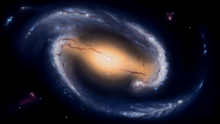
The Blossom Galaxy from intergalactic space.
The Blossom Galaxy is a unique dwarf barred spiral galaxy orbiting the Flower Galaxy relatively distantly and the largest satellite of the Flower Galaxy. Its nations are members of the United Nations of the Flower Galaxy, and are highly militarized to defend against a possible NTIH attack, as any attack from them would have to go through the Blossom Galaxy.
The Blossom Galaxy is relatively sedate in most areas, with most stars being over a billion years old. This leads to a distinct lack of massive stars such as Wolf-Rayets. The galaxy is also of the "Grand Design" subtype, which means that its spiral arms are very well defined and beautiful, with the space between the arms almost as sparse as the halo.
Akradax Galaxy
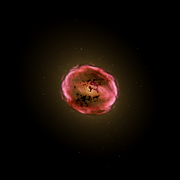
The Akradax Galaxy, with its distinct star-forming region.
The Akradax Galaxy is a medium-sized dwarf elliptical galaxy orbiting the Flower Galaxy. It is almost entirely controlled by the Akradax Collective, which is one of the more reclusive members of the UNFG, aside from a small PPFN colony. The Akradax Galaxy is full of megastructures, due to the Akradax Collective's focus on internal development.
The Akradax Galaxy is also home to the Akradax Molecular Cloud Complex, a large star-forming region surrounding the galactic core. This is unique for dwarf ellipticals, with the only other known structure like this located in the Suvaren Galaxy, almost ten million light-years distant. The nebula is being mined for gases and dust, to conserve resources which would otherwise be spread apart and lost.

The Lance Galaxy, a small elliptical galaxy slowly being torn apart by the Flower Galaxy. The tidal stream of stars and gas is visible here.
Lance Galaxy
The Lance Galaxy is a tiny galaxy orbiting very close to the Flower Galaxy's disk. It is being slowly ripped apart by the gravity of its parent galaxy, and is being stretched out into a vast ring. It only has two contacted civilizations, and its outer fringes are colonized by many nations of the UNFG. The Lance Galaxy has almost no young stars, and most of its stars have very low metal content. Because of this, terrestrial planets are relatively rare, which further decreases the likelihood of civilizations developing.
The Lance Galaxy is home to many anomalies, including many dim Aroteon Stars, among other things. Some nations call it the Castrella Galaxy, for some reason. The faint stellar ring caused by the galaxy's stretching out has been colonized by the Kingdom of Saihera, as it passes through its heartlands.
The Lance Galaxy is nominally fully controlled by a native UNFG member nation known as the Encalet Confederacy, but the Confederacy is currently split between the current government and a nationalist anti-UNFG xenophobic group known as the Nationalist Liberation Front, working to violently split the Confederacy away from the UNFG.
They currently control roughly half the galaxy from their base at the hidden planet of Parvakel. Diplomatic officers from various other member nations of the UNFG are trying to calm this conflict down, but to no avail.
Morid Galaxy

The Morid Galaxy. It's less of a galaxy and more of a loose conglomeration of dim, dying stars and neutral, cold gas.
The Morid Galaxy is a small, dim blob of a galaxy in the outer reaches of the Flower Subgroup. It seems to have no intelligent species, and is littered with massive amounts of ruins, likely from an extinct civilization. The Morid Galaxy consists almost entirely of old, metal-poor stars, and is completely devoid of gas.
It is hypothesized that this extreme lack of gas, unparalleled in anything that isn't a globular cluster, was caused by a massive starburst formation where thousands of very high-mass stars formed at almost exactly the same time, causing the civilization living there at the time, the Moridian High Command, to be rapidly wiped out. The extreme amount of radiation coming from the short-lived stars also sterilized any and all potentially life-giving planets as the lack of gas precluded the formation of any new stars.
Nellai's Object
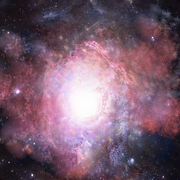
Nellai's Object from the Blossom Galaxy, featuring its densely packed bright stars and nebulae.
Discovered by renowned Carlean astronomer Onir Nellai, Nellai's object is a strange galaxy. It is absolutely miniscule, at just 850 light years across, but it contains around 123 million stars. Nellai's object is also a quasar, emitting high-energy radiation in two opposite directions. It is currently going through an intense starburst spree, forming at a rate of 430 stars every year. Nellai's object is intensely pink, with hints of blue, green and red across its strange filaments of gas, which almost resemble spiral arms. Over a million OB stars, over 30,000 Wolf-Rayet stars and over 1,000 aroteon stars have been documented in Nellai's object, and it is currently the most inhospitable known galaxy in the Flower Galaxy's systems. Fortunately, in around 20 million years, Nellai's object's starburst phase will end, but the "galaxy" will still be extremely dense and quite inhospitable. It is a distant subsatellite of the Blossom Galaxy.
There is only one documented habitable planet in the entire galaxy, located on the edges. Nakuvoas is the only colony in the entire galaxy, a barely habitable icy rogue planet, warmed only by the light of many stars light years away. Work is being done to put Nakuvoas in a stable orbit around a nearby star. Currently it is shared by the entire United Nations of the Flower Galaxy.
Minor Satellites
| Image | Name | Stars | Type | Notes | Under Control Of |
|---|---|---|---|---|---|
| Elat Galaxy | 10 million | Irregular | Very distant | ||
| Paloa Galaxy | 5 million | Dwarf Elliptical | Subsatellite of the Lareas Galaxy | ||
| Yuares I | 2 million | Irregular | No one's entirely sure if these two are actually Flower satellites or just free-floating | ||
| Yuares II | 1.5 million | Irregular | |||
| Oria Galaxy | 900,000 | Ultra-diffuse | Extremely sparse, almost half the size of the Flower Galaxy itself but with only 900,000 stars. | ||
| Azertus Galaxy | 750,000 | Irregular | Subsatellites of the Blossom Galaxy. | ||
| Verta Galaxy | 600,000 | Dwarf Elliptical | |||
| Asontes Cloud | 400,000 | Irregular | The only extragalactic colonies of the Cnara-Frealee Federation are located here. | ||
| Trille Dwarf | 350,000 | Irregular | This is a particularly active galaxy, with many stars being formed. Not quite as extreme as Nellai's Object, though. | ||
| Treita I | 250,000 | Dwarf Elliptical | This galaxy is not particularly interesting, but it does have a high concentration of dim Aroteon Stars | ||
| Treita II | 180,000 | Irregular | Treita II contains a thriving interstellar ecosystem, and contains a strangely small number of large planets. | ||
| Treita III | 140,000 | Irregular | Very near Treita II, and is similarly populated by the space creatures. | ||
| Treita IV | 100,000 | Irregular | Smallest nondisputed satellite galaxy. | ||
| Yutze Overdensity | 100,000 | Intergalactic Overdensity | Disputed whether this is a satellite. | - |
Notable Globular Clusters
Nalachi Cluster
🠊 Main article: Nalachi Cluster
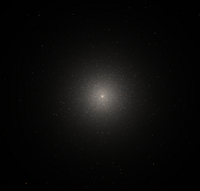
The Nalachi Cluster is a major cluster above the galactic disk of the Flower Galaxy. It is controlled almost entirely by the Pecay-Po Federation of Nalachi, which also controls the sparsely populated galactic halo surrounding it.
Nalachi is an unusually large globular cluster, at 250 light-years in diameter. It is relatively densely packed, making it the largest and brightest globular cluster in the Flower Galaxy's neighborhood. Nalachi's center is occupied by a large black hole unimaginatively known as the Heart of Darkness. The Nalachi Cluster, other than this, contains many ancient artifacts from the ancient Pecay-Po Federation of Nalachi, which is a lot older than it looks.
Exurian Cluster
🠊 Main article: Exurian Cluster
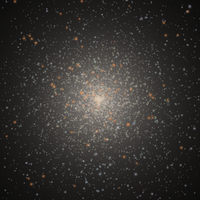
The Exurian Cluster is the largest globular cluster of the Myrmidan Galaxy. It is fully controlled by the Exurian Union, a nation closely allied with the United Nations of the Flower Galaxy, which has sent the vast majority of its military to help in the Ardaya Conflicts.
Exurian is a relatively large globular cluster, that is unusually dense in its inner parts. Because of this, most everyone outside it who discovered it assumed that it was much smaller than it actually is, because of this extreme density gradient. However, the Exurian Union is currently constructing a relatively small Birch Planet out of the inner stars of the cluster, to concentrate its population. The outer stars are being left alone, to serve as a destination for Project Alazar.
Maps
Maps of all satellites.
Timeline
Key
Any editor of things in the Flower Galaxy may add to this timeline to include events in their work.
Anything in bold is considered to be a major event.
BCE - Before Common Era
CE - Common Era
Before Common Era
| 13,000,000,000 BCE: | - The Flower Galaxy fully forms.
- The Heart of Providence is created. |
|---|---|
| 12,990,000,000 BCE: | - The Blossom Galaxy fully forms.
- The Lareas Galaxy fully forms. |
| 12,890,000,000 BCE: | - The Akradax Galaxy fully forms.
- The Myrmidan Galaxy fully forms. - The Lance Galaxy splits from a spiral arm of the Flower Galaxy. |
| 12,610,000,000 BCE: | - The Morid Galaxy fully forms.
- The Lowiras Galaxy fully forms. - The Gladijon System forms. |
| 12,480,000,000 BCE: | - The Nalachi Cluster and all its stars form.
- The Kormin System forms. |
| 12,300,000,000 BCE: | - The majority of the stars in the Akradax Galaxy, except those currently forming in the Snow Globe nebula, form. |
| 12,250,000,000 BCE: | - The Garanka System forms. |
| 11,800,000,000 BCE: | - The Formation Era ends and the galaxy becomes habitable for the first time.
- The Talusi system forms. |
| 11,140,000,000 BCE: | - The Parvo-Aa System begins to form. |
| 10,032,000,000 BCE: | - The Aolia System forms. |
| 9,210,000,000 BCE: | - Rexisa and the Reinne System form. |
| 8,590,000,000 BCE: | - The Eldur System forms.
- The Hajax System forms. |
| 8,230,000,000 BCE: | - The Urakai System forms.
- The Poranna System forms. |
| 7,128,320,000 BCE: | - The Lareas Alliance begins expanding out of its host galaxy. |
| 7,000,000,000 BCE: | - The Lareas Alliance reaches its peak.
- The Apricot System forms. |
| 6,985,191,404 BCE: | - The Lareas Alliance mysteriously vanishes.
- The Beltamos System forms. |
| 6,530,000,000 BCE: | - The Archas System forms.
- The Andred System forms. |
| 5,900,000,000 BCE: | - The Vureka System forms.
- The Uxre System forms. |
| 5,300,000,000 BCE: | - The Rikance System forms.
- The Golda System forms. - The Meere System forms. |
| 5,110,000,000 BCE: | - The Kenna System forms. |
| 4,950,000,000 BCE: | - The Vespira System forms.
- The Mizadan System forms. - The Alkatrad System forms. |
| 4,500,000,000 BCE: | - The Erinor System forms. |
| 3,200,000,000 BCE: | - The Cnara System forms.
- The Toralaskis System forms |
| 2,700,000,000 BCE: | - The Ardaya System forms.
- The Elgon System forms. |
| 2,500,000,000 BCE: | - The 'Morid Flash' occurs, wiping out the Moridian High Command |
| 2,400,000,000 BCE: | - The first iteration of the Providence Union is founded. |
| 2,017,000,000 BCE: | - The Airozes System forms.
- The rogue planet Polinia is ejected from an unknown system. - The Xeros System forms. - Nellai's Object forms. |
| 1,800,000,000 BCE: | - The Frealee System forms.
- The Ravres System forms. - The Arella System forms. |
| 1,711,000,000 BCE: | - The Entelir System forms. |
| 1,427,000,000 BCE: | - The Castro-Lux system forms.
- The Elidoro System forms. |
| 1,143,000,000 BCE: | - The Doret System forms.
- The Alseker System forms. |
| 950,000,000 BCE: | - The last iteration of the Providence Union is utterly destroyed.
- The Feres System forms. - The Quorom System forms. |
| 596,000,000 BCE: | - Nakuvoas forms. |
| 580,000,000 BCE: | - The Karu System forms.
- Nakuvoas is ejected from an unknown star in Nellai's Object. |
| 380,000,000 BCE: | - The Lareas Galaxy reaches its closest point.
- The Saihera System forms. |
| 370,000,000 BCE: | - The Tarea System forms. |
| 17,590,000 BCE: | - Birran forms.
- The Dorok System forms. |
| 4,500,000 BCE: | - The Telusian Civilization conquers the Flower Galaxy and most of its satellites.
- The Radul System forms. |
| 3,000,000 BCE: | - The Telusian Civilization slowly falls.
- Narenna forms. |
| 1,900,000 BCE: | - The Treana System forms. |
| 1,500,000 BCE: | - Fornes forms.
- Kerrem forms. |
| 1,210,000 BCE: | - The Plokeon Binary forms. |
| 230,047 BCE: | - The Akradax Collective is founded. |
| 148,033 BCE: | - The Pecay-Po Federation of Nalachi is founded. |
Common Era
| 29,001 CE | - Sagittarium begins conquering a portion of the Elerad Arm. | ||
|---|---|---|---|
| 31,434 CE | - The vast majority of Sagittarium's claims are abandoned upon the death of Klein Vay. | ||
| 48,903 CE | - The Economic Federation of Saleas is founded from many smaller states in and around the Parvo-Aa System. | ||
| 53,491 CE | - The Cnara-Frealee Federation is created from the union of the Cnaran Federation and Darvikan Union. | ||
| 62,237 CE | - The Marakat Interstellar Union is founded from the merger of the prefects of Artaclate, Perol, and Vea. | ||
| 69,801 CE | - The Providence Neutral Zone is created with the signing of the First Treaty of Providence. | 70,745 CE | - The Great Lareas War begins.
- Marnaltharke is destroyed. - The attack on the Narenna Dyson Swarm occurs. |
| 72,433 CE | - The War of Saiheran Succession begins. | ||
| 76,808 CE | - The War of Saiheran Succession is ended with the Fifth Treaty of Providence.
- The United Nations of the Flower Galaxy is also formed with said treaty. |
Notable Celestial Objects
- Cnara System - Home system of the Cnara-Frealee Federation, binary system with a red giant and a red dwarf
- Frealee System - Secondary home system of the Cnara-Frealee Federation, large system with a F-type star
- Heart of Providence - large Intermediate-mass black hole at the center of the galaxy
- Birran - White supergiant close to the Cnara system, quite bright and helped the Cnara-Frealee Federation advance to the K2 stage, also contains some elusive Telusian artefacts left from the Telusian era
- Saihera System - A small system in the galactic halo, with two lifebearing planets. The Kingdom of Saihera migrated here in their early days when their home star died.
- Treana Nebula - largest nebula in the galaxy and its satellites, home of another civilization
- Treana System - ternary wolf-rayet star system, center of the Treana Nebula and one of the most extreme stellar systems in the entire galaxy
- Fornes - giant evolved cool star, best described as a red hypergiant. May be a quasi star, near Treana
- Eimvas - hypervelocity O-type main sequence star, once had a close encounter with the Treana System
- Radul - hypervelocity binary between a Wolf-Rayet star and a neutron star in the galactic halo, with a large nebula surrounding it
- Narad - Brown dwarf, home system of the Somnar Hive in the Myrmidan Galaxy. Not much is known about it.
- The Grey Star - Anomalous light-emitting area of space within the outskirts of the galaxy.
- Plokeon - A binary star with a wolf-rayet star and an evolved supergiant star, in the Charity Arm.
Full List of Systems
Flower Core
 Cnara System
Cnara System Heart of Providence
Heart of Providence Gladijon System
Gladijon System Birran
Birran Elidoro System
Elidoro System
Frealee Arm
 Frealee System
Frealee System Tarea System
Tarea System Parvo-Aa System
Parvo-Aa System Apricot System
Apricot System Vespira System
Vespira System Mizadan System
Mizadan System
Charity Arm
 Plokeon
Plokeon Kenna System
Kenna System Rikance System
Rikance System Feres System
Feres System Quorom System
Quorom System Golda System
Golda System Lyak System
Lyak System Quanta System
Quanta System Khae System
Khae System Vastra System
Vastra System Waros System
Waros System
Elerad Arm
 Treana System
Treana System Castro-Lux System
Castro-Lux System Aolia System
Aolia System Dorok System
Dorok System Fornes System
Fornes System Garanka System
Garanka System
Paleas Arm
 Beltamos System
Beltamos System Alkatrad System
Alkatrad System Elgon System
Elgon System Arella System
Arella System Urakai System
Urakai System Reinne System
Reinne System Palos System
Palos System Auralumina System
Auralumina System Criuden System
Criuden System Tranquility System
Tranquility System Darvis System
Darvis System Kalista System
Kalista System
Akris Arm
 Xeros System
Xeros System Gannet Matrioshka
Gannet Matrioshka Toralaskis System
Toralaskis System Backup Rendezvous System
Backup Rendezvous System
Galactic Halo
 Radul System
Radul System Saihera System
Saihera System Aiah
Aiah Cellen System
Cellen System Tulach System
Tulach System Poralor System
Poralor System Tarin System
Tarin System Flammes System
Flammes System Ta'Koro
Ta'Koro
Myrmidan Galaxy
 Ardaya System
Ardaya System Poranna System
Poranna System Narad System
Narad System Vekeres System
Vekeres System
Lareas Galaxy
 Narenna System
Narenna System Miraban System
Miraban System Archas System
Archas System

 Talusi System
Talusi System Airozes System
Airozes System Eye of Conscience
Eye of Conscience Kormin System
Kormin System Elerr System
Elerr System
Blossom Galaxy
 Eldur System
Eldur System Andred System
Andred System Polinia
Polinia Ravres System
Ravres System Doret System
Doret System Suyralo System
Suyralo System Alseker System
Alseker System
Akradax Galaxy
 Dalthazar System
Dalthazar System Iris System
Iris System Osser System
Osser System Toralea
Toralea Kerrem
Kerrem Cireasei
Cireasei
Lance Galaxy
Morid Galaxy
Nellai's Object
Notable Anomalies


 Chara-Saihera Path
Chara-Saihera Path

 Orachis-Kenna Path
Orachis-Kenna Path- Faresae
- Aroteon Stars
- Shifting Dwarfs
- Keligan Stars
 The Grey Star
The Grey Star















































